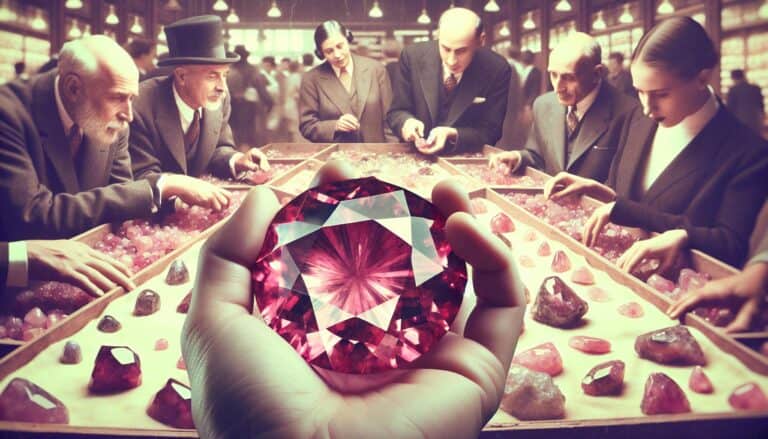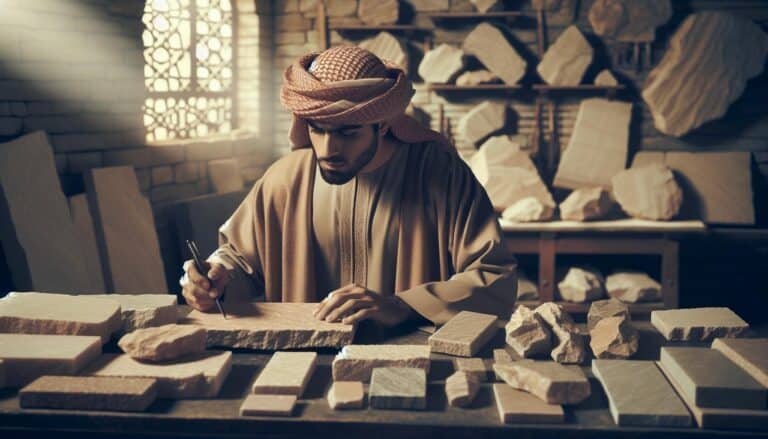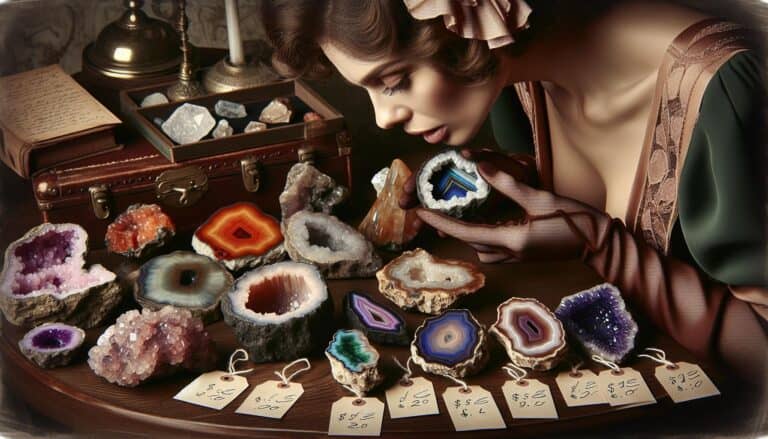Discovering the secrets of identifying beryl is like unlocking a chest of colorful treasures.
Beryl, a mineral that ranges from emerald to aquamarine, is as fascinating as it is beautiful. You’re about to learn the key characteristics that make beryl stand out in the gem world.
Whether you’re a budding gemologist or simply a rock hound, knowing how to spot beryl is a skill that’ll enhance your appreciation for this remarkable mineral.
Get ready to dive into the world of beryl with clarity and confidence.
To identify genuine beryl, observe its hexagonal crystals and color range from green (emerald) to blue-green (aquamarine). Beryl leaves a white streak, is non-magnetic, ranks 7.5-8 on the Mohs scale, and is singly refractive. It has a refractive index of 1.57-1.60 and specific gravity of 2.6-2.8.
How to Identify Beryl Through Testing
Visual Inspection
You’ll want to start with the basics. Observe the specimen’s color, transparency, and crystal form. Beryl boasts a range of hues—green for emerald, blue to blue-green for aquamarine, pink for morganite, and more. Look for its hexagonal crystal structure, another dead giveaway.
The Streak Test
Drag your beryl specimen across a porcelain streak plate to observe the color of the streak it leaves behind. Beryl typically leaves a white streak, which can help to differentiate it from other minerals.
Magnet Test
Beryl isn’t magnetic, so if your specimen is attracted to a magnet, it’s likely not beryl. This test quickly eliminates certain types of imposter minerals.
Hardness Test
With a Mohs hardness scale at your disposal, scratch your specimen with a tool of known hardness. Beryl will rank at 7.5 to 8, meaning it can scratch glass but not corundum.
Birefringence Test
Through birefringence testing, assess how the beryl specimen splits light. Beryl’s anisotropic properties mean it’ll have double refraction though it’s not as pronounced as in minerals like calcite.
Checking The Diaphaneity
Examine how light passes through the beryl. Beryl ranges from transparent to translucent. This characteristic helps in ruling out minerals with different light transmission properties.
Single or Double Refraction
Observe the stone under a polariscope to discern if it’s singly or doubly refractive. Beryl is often doubly refractive due to its uneven crystal structure.
Refractive Index Test
By determining the refractive index, or RI, you can confirm beryl’s identity. Common beryl’s RI ranges from approximately 1.57 to 1.60, unique enough for positive identification.
Finding The Specific Gravity
Investigate the specimen’s specific gravity using a hydrostatic balance or a density kit. Beryls fall within 2.6 to 2.8, which is considerably lighter than other similar-looking minerals.
Identifying Beryls in the Field
Arm yourself with a UV light to spot fluorescent reactions; some beryl varieties glow. Additionally, knowing the typical geological formations such as granite pegmatites where beryl can be found, aids in field identification.
Recognizing Potential Beryl Rocks
Keep an eye out for rocks with telltale signs of beryl. Look for hexagonal prisms and aquamarine or emerald green colors indicative of possible beryl presence. Remember, knowing your beryl may require cumulative tests for verification.
Physical Characteristics of Beryl

Beryls are prized for their vibrant colors and stunning clarity, which can greatly vary depending on their type. Aquamarine and emerald are well-known beryl varieties, with the former displaying a serene blue hue and the latter a rich green. When you’re on the hunt for beryls, pay special attention to the color and transparency of the specimens you find.
Color Range and Saturation
Beryl’s color range can be wide. Emeralds are best known for their deep green color, whereas aquamarines boast shades of blue. Morganite offers a soft pink, and heliodor presents a warm yellow. It’s crucial to note that a beryl’s color can affect its value—deeper and more vivid hues are typically more sought after.
Crystal Structure and Shape
Beryl crystals are hexagonal, a distinctive feature that can aid in identification. These crystals grow in columnar or tabular shapes, which can sometimes appear quite large and well-formed. They’re renowned for their clarity, although some variations contain inclusions that can aid in identification and sometimes even increase their aesthetic value, as seen in trapiche emeralds.
Remember, beryl should be transparent to translucent in clarity, which can be confirmed through a diaphaneity test discussed earlier. Assessing the physical characteristics of beryls you come across is a foundational step in recognizing whether you’ve got an authentic stone or an imitative material in your hands. Familiarize yourself with their unique attributes for more confident field identification.
How Are Beryl Formed?
Beryl originates deep within the Earth’s crust under high temperature and pressure conditions. Mineral-rich fluids and gases permeate through the cracks and cavities in rocks, where beryllium, aluminum, silicon, and oxygen crystallize to form this unique mineral.
While exploring the formation process, here’s what you should know:
- Pegmatites, coarse-grained igneous rocks, are the primary source of gem-quality beryl.
- These rocks form during the final stages of magma crystallization, creating environments rich in rare elements.
- Geochemical conditions, like the presence of certain elements and their concentration, influence the variety of beryl that forms.
For instance, when manganese accumulates in the crystal structure, you’ll find pink beryl, also known as morganite. Trace amounts of chromium or vanadium yield the coveted green emerald. Aquamarine gains its signature blue from iron impurities.
In addition, sometimes, beryl forms in metamorphic rocks, signifying they have undergone transformation by heat and pressure. However, these occurrences are less common compared to their development in igneous rocks.
Understanding the formation process of beryl not only satisfies your curiosity but also aids in gauging where deposits may be located. Geological history of an area can give you clues about potential beryl sites. Keep this in mind as you venture into the field, armed with knowledge that can increase your chances of uncovering authentic beryl samples.
Preparation for Beryl Hunting
Before you set out on your beryl hunting adventure, there’s some essential preparation you need to tackle. Having the right tools at hand and taking necessary safety measures will equip you for success in the field. Here’s how you can get ready for the quest for beryl.
Gathering the Right Tools
To maximize your chances of finding beryl, you’ll need a kit of specific tools tailored for mineral hunting. First and foremost, a good-quality geologist’s hammer will help you gently break apart rocks to reveal any beryls hiding within. You’ll also want to pack:
- Safety goggles to protect your eyes from flying debris
- A sturdy set of chisels and a loupe or magnifying glass for closer inspection of potential finds
- Durable gloves to protect your hands during digging and handling rough stones
- A field guidebook on minerals, which can help you identify beryl and related minerals on the spot
- A GPS device or detailed map to navigate the terrain
- Comfortable, waterproof boots for traversing a variety of landscapes
Bring along collection bags or containers too; they’ll keep your finds safe during transport.
Safety Considerations
When hunting for beryl, your safety should be your top priority. Always inform someone of your whereabouts and expected return time before heading out—it’s a simple step that can make a big difference in case of an emergency. Here are additional safety tips to follow:
- Check the weather forecast and be prepared for sudden changes in conditions
- Wear appropriate clothing—layers are ideal for variable temperatures, and bright colors make you easily visible to others
- Bring sufficient water and food to maintain your energy levels throughout the day
- A first-aid kit is a must-have should minor accidents occur
- Be wildlife aware; know how to respond if you encounter local fauna
- Consider the legal aspects of mineral hunting; always seek permission if you’re entering private property and respect the land by following a leave-no-trace ethic
By following these steps, you’ll ensure you’re well-prepared for finding beryl. With your tools in hand and safety measures in place, you’re ready to start the exciting process of discovering these beautiful gems in their natural setting.
Handling and Care of Found Beryl

Once you’ve successfully located and extracted beryl from its natural environment, it’s essential to know the proper techniques for handling and care to maintain its condition and appearance. This aspect is not to be overlooked as it ensures the longevity and beauty of your treasured finds.
Cleaning Beryls
Cleaning your beryl gems is a delicate process that should be approached with caution to prevent any damage. Initially, remove any dirt or debris by using a soft brush, like a toothbrush, under lukewarm running water. Avoid using harsh chemicals or ultrasonic cleaners as they can harm the stone. For a more thorough cleaning, you can prepare a mild soap solution:
- Mix warm water with a few drops of mild dish soap.
- Soak the beryl in the solution for a short period.
- Gently scrub with a soft toothbrush.
- Rinse thoroughly to remove soap residue.
- Pat dry with a lint-free cloth.
Remember that beryls have a relatively high hardness rating but can still be scratched or damaged if mishandled.
Storing Beryls
Proper storage of beryls is key in preventing scratches and preserving their quality. It’s important to store them separately from other gems and jewelry to avoid contact damage. Here are some storage tips:
- Wrap each beryl in a soft cloth or place it in a fabric-lined jewelry box.
- If using a box with compartments, ensure each beryl is in its own section.
- Avoid extreme temperatures and direct sunlight as they can cause fading or internal stress.
- Consider using acid-free tissue paper for wrapping if you’ll be storing beryls long-term.
By following these cleaning and storage guidelines, you’ll keep your beryl collection in pristine condition. Whether you’re a seasoned collector or a hobbyist, these fundamental care instructions will ensure that your beryls retain their allure for years to come.
Conclusion: Confirming Beryl is Real
Armed with the right knowledge and tools, you’re now equipped to confidently identify beryl in the wild.
Remember, assessing the physical properties and conducting various tests are key to distinguishing genuine beryl from look-alikes. Whether you’re in the field or examining a potential find at home, careful observation and testing are your allies. With your newfound skills, you’re ready to handle and care for your beryl treasures, ensuring they remain as lustrous as the day you found them.
Happy hunting, and enjoy the beauty and satisfaction that comes with discovering and preserving these precious gems.







